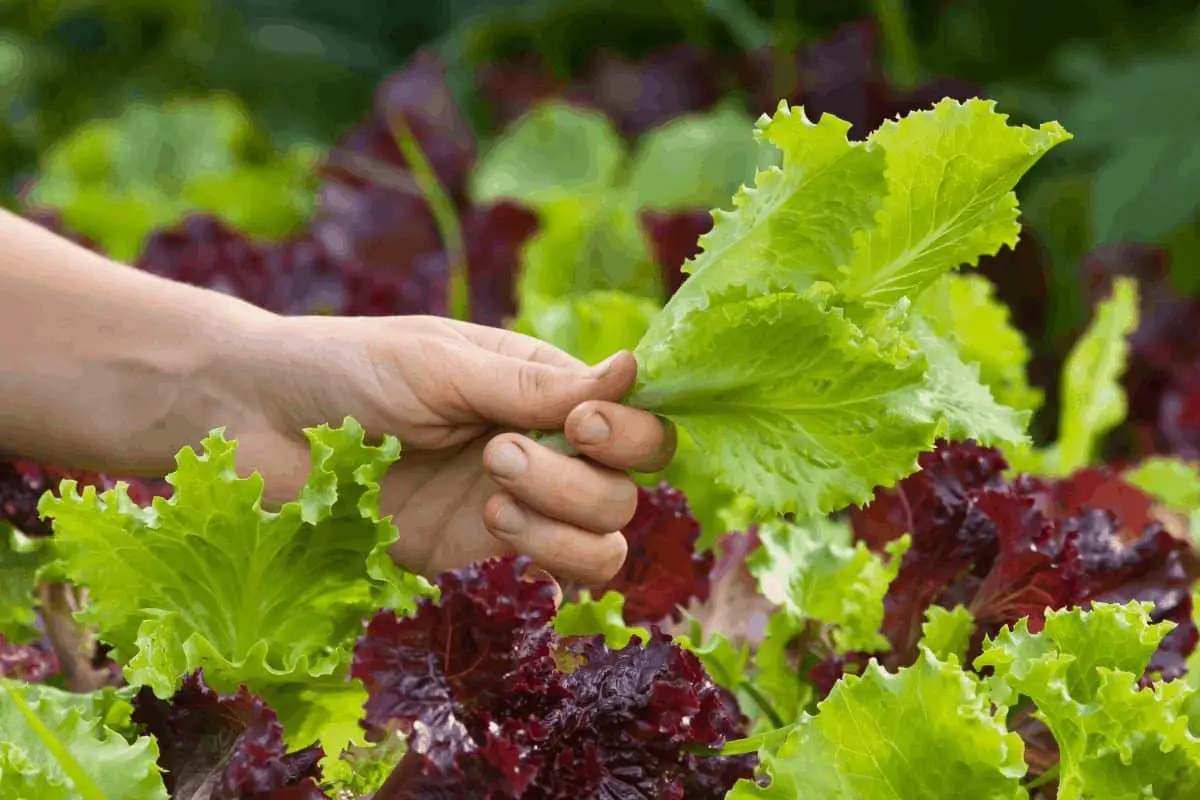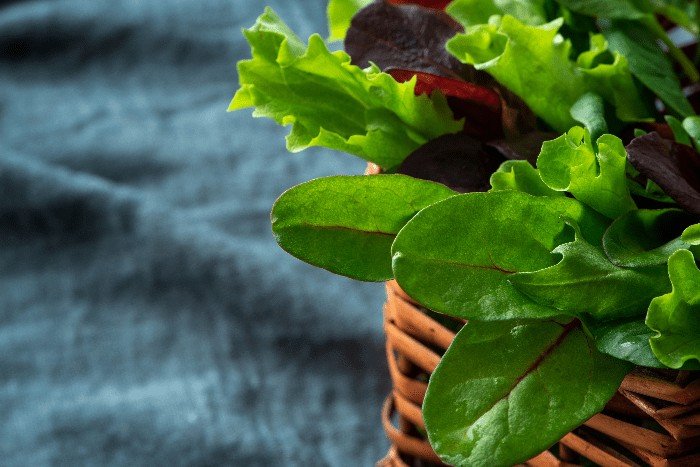Last Updated on December 24, 2022 by Tony Manhart
Lettuce is a scrumptious leafy vegetable that works great in salads or on burgers, so it makes sense that gardeners would want a supply to keep their lettuce leaves fresh and ready for cooking. However, people are often confused about the right way to cut lettuce from the garden, especially if they want the plant to continue to produce. Luckily for you, lettuce is straightforward and can be cut and cleaned with no problem, so you will finally have an answer to What is the right way to cut lettuce from the garden?
How to Cut Lettuce from the Garden
Lettuce is a cold-weather plant that grows well in gardens, but it can be difficult to determine the right way of cutting it. Overall, gardeners can choose whether they want to cut the lettuce so it is fully removed, or if they want to leave a portion behind so it continues to grow throughout the year.
Cutting Lettuce to Fully Remove
Cutting lettuce to take it from the garden is a simple task since this vegetable is uncomplicated. The first step is to make sure the plant is full-sized but hasn’t quite matured, as this is when the leaves are the most tender. The best time to harvest the leaves will be in the early morning when they are the most crisp and fresh.
Depending on the type of lettuce you have, you can either remove the loose leaves and then dig out the stem, or cut the stem about 1 in. from the ground and then dig out the stem and roots so the plant doesn’t grow back. Lettuce can be replanted annually and grows well, so this vegetable is versatile and can be grown again and again.
Cutting Lettuce to Grow All Year
If you want to continue to have delicious lettuce throughout the year, then you should get a pair of scissors and carefully clean the blades. Disinfect the surface with rubbing alcohol or a similar material. This helps prevent contamination of the lettuce plant with bacteria and other unsavory elements.
Once the scissors are ready, cut the lettuce leaves at 1 in. above the crown, so the leaves can continue to grow with the inch left behind. To further preserve the plant, try to only cut the lettuce when the leaves are between 3 and 6 in. long.
When the lettuce is cut, make sure the remaining plant has enough moisture and sunlight to continue to grow. Avoid overwatering and the temptation to use fertilizer.
Do Different Species Use Different Methods?
Individuals often forget that there is more than one type of lettuce, and many of them are far more delicious than the traditional iceberg. Depending on your location, you might be able to grow one of the following varieties, each of which has a different taste, texture, and appearance: leaf, romaine, iceberg, Boston, butterhead and bibb.
In general, the multiple varieties of lettuce should be harvested using the same methods listed above. A couple of types are easier to cut at the base rather than try to harvest leaf by leaf, including romaine, butterhead, and head. Iceberg can sometimes be removed by cutting close to the ground, but anyone who uses this method will need to chop and clean the plant thoroughly before trying to eat it.
If you do want to harvest lettuce leaf by leaf, be warned that the process can take a long time, and the leaves will need to be washed individually and stored in a safe and clean container. They also might not last as long as lettuce cut directly at the head.
How to Clean Lettuce
Cleaning lettuce is half of the battle once it has been removed from the garden. Many varieties are quite similar and follow the same process. Cleaning will be simpler if you have a salad spinner, as it spins away excess moisture off of the leaves once washing is complete. This means the lettuce will be ready for storage right away.
To cut lettuce, you first need to cut the head in half and remove the tough stem core that grows through the center. You will then need to eliminate any damaged or soft leaves, as these aren’t the best to eat and can actually make the lettuce decay faster than it originally would. Trimming is necessary for head and leaf lettuce varieties, so keep this in mind when cultivating.
Second, you need to fill a clean sink or bowl with lukewarm water. Avoid using hot water because it will ensure the lettuce wilts and is no longer crisp, fresh, and delicious. Coldwater also isn’t the best because the lettuce will stiffen and be more difficult to scrub.
Once you have the water, submerge the lettuce in water and swish the leaves around for roughly 30 seconds. Drain immediately afterwards and rinse any grit that winds up in the bowl or sink. You should then fill the container with some cold water and rinse the leaves again. If there is still grit, fill the bowl a third time to treat the leaves.
Third, put the fresh leaves in a salad spinner to remove excess water. Then, transfer the leaves to a colander and allow them to sit for a couple of minutes. Blot them dry with a clean paper towel afterwards to eliminate any moisture that is left behind.
Fourth, it’s time to place the dry lettuce in a plastic bag with another paper towel. This towel will collect anything that seeps out of the leaves, keeping them crisp even while in the fridge. When properly cut and cleaned, lettuce can be stored in a refrigerator drawer for up to one week.
Conclusion
Cutting and cleaning lettuce should be easy, and you can be in and out of the garden and kitchen in less than half an hour. Just be sure to know your variety well and you can enjoy crisp and refreshing salads, burgers, and garnishes from the comfort of your own home with produce you grew yourself.
FAQs
How far down do you cut lettuce from the garden?
The best way to determine how to cut lettuce is by looking at what's already available in your fridge and freezer. If you have a head of lettuce, you can use that as your main guide. You can also keep an eye on how much time has passed between when you planted the lettuce and now.
You need to be careful, because if the leaves are too long they will become tough and won't last as long.
Lettuce has a relatively short lifespan. It can start wilting after only two days if you cut it too close from the plant’s stem, but if you wait until three or four days after cutting, it will stay fresh longer and grow better.
How many times can lettuce be harvested?
By harvesting the lettuce before it spoils, farmers are able to maintain quality, reduce waste and improve productivity.
It depends on what type of lettuce you are growing. Generally speaking though, lettuces may only be harvested once or twice before they start to lose their nutrients.
How long does it take to regrow lettuce?
The time it takes for lettuce to grow is not the same for every leaf. There are some leaves that can regrow in a few days while others have a longer time frame.
The time it takes for lettuce to regrow varies depending on the type of lettuce, how much water and nutrients the plant gets, and how long it was left before being harvested.
Do you have to replant lettuce every year?
Lettuce is a plant that needs to be replanted after it is cut. This means that plants grow from the cut, and it takes about a week for new lettuce to take root and form a new plant. However, some people argue that lettuce grows from the last set of leaves before the cut.
There are some benefits to planting lettuce every year as well. It will allow you to enjoy fresh leaves all year round because it will still produce roots even if you do not replant them.
Should you cut lettuce with a knife?
You should not use a knife to cut lettuce. This is because the sharp blade can tear the leaves. Instead, you should use a chef's knife to make thin slices of the lettuce and then serve it on a plate.
Cutting lettuce with a knife will result in tears and shredding of the leaves. This is because the blade makes contact with the leaf tissue. A chef’s knife, however, allows for more precision when cutting lettuce with its thin blade that does not damage or tear leaves at all.
Are you supposed to cut or tear lettuce?
Whether you should cut or tear lettuce depends on the type of lettuce that you are using and what you plan to use it for. Cutting lettuce will provide a smoother texture while tearing leaves pieces might be more ideal to add crunchiness.
Does cutting lettuce make it go bad faster?
Cutting lettuce can make it go bad faster than if you don't cut it. However, the impact of the cutting on the lettuce's appearance is minimal.
A recent study found that cutting lettuce made it go bad more quickly and it looked worse after the cutting. However, this was based on a chemistry experiment in a lab and not an experiment on lettuce to see how long it would last.
Tony Manhart is a passionate gardener who has been tending to gardens for over 20 years. He takes pride in creating beautiful outdoor spaces with plants, trees, and shrubs that can thrive in any environment. He loves to share his knowledge with others and has taught classes on gardening basics and advanced techniques. He is committed to sustainability, using natural and organic methods to create and maintain gardens. He also works with local organizations to create green spaces for communities. When he’s not gardening, Tony enjoys hiking, reading, and spending time with his family.




